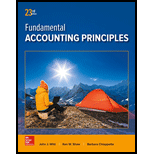
Journal entry is a way of recording the financial transaction of the company related to certain dates that shows chronological effect in the books of accounts. Journal entries are recorded on the basis of dual aspect accounting method.
Accounting Rules for Journal Entries:
⮚ To increase balance of the account: Debit assets, expenses, losses and credit all liabilities, capital, revenue and gains.
⮚ To decrease balance of the account: Credit assets, expenses, losses and debit all liabilities, capital, revenue and gains.
Assets Disposal:
Assets when disposed off may be beneficial for the company which is totally depends on the book value of the assets. If disposal amount is greater than book value there would be profit otherwise loss to the company.
To prepare: journal entry to record the disposal of the milling machine on January 3 under given independent situations.
Want to see the full answer?
Check out a sample textbook solution
Chapter 10 Solutions
Fundamental Accounting Principles
- I need guidance with this financial accounting problem using the right financial principles.arrow_forwardI need help with this general accounting question using the proper accounting approach.arrow_forwardI need help with this financial accounting question using accurate methods and procedures.arrow_forward
- What is the amount of operating cash flowarrow_forwardYamamoto Corporation began the accounting period with $92,000 of merchandise, and the net cost of purchases was $318,000. A physical inventory showed $104,000 of merchandise unsold at the end of the period. The cost of goods sold by Yamamoto Corporation for the period is __. need helparrow_forwardI need help with this general accounting problem using proper accounting guidelines.arrow_forward
- An asset owned by Crescent Manufacturing has a book value of $36,000 on June 30, Year 5. The asset has been depreciated at an annual rate of $8,000 using the straight-line method. Assuming the asset is sold on June 30, Year 5 for $39,500, how should the company record the transaction? a. Neither a gain nor a loss is recognized on this type of transaction. b. A gain on sale of $3,500. c. A gain on sale of $5,000. d. A loss on sale of $3,500. e. A loss on sale of $5,000.arrow_forwardI am looking for help with this general accounting question using proper accounting standards.arrow_forwardCan you explain the correct approach to solve this financial accounting question?arrow_forward
- Jacobson Co. recently reported a net income of $7,840 and depreciation of $1,250. How much was its net cash flow, assuming it had no amortization expense and sold none of its fixed assets? HELParrow_forwardWhat is the value of the ending inventory for the year?arrow_forwardGet correct answer with accountingarrow_forward

 AccountingAccountingISBN:9781337272094Author:WARREN, Carl S., Reeve, James M., Duchac, Jonathan E.Publisher:Cengage Learning,
AccountingAccountingISBN:9781337272094Author:WARREN, Carl S., Reeve, James M., Duchac, Jonathan E.Publisher:Cengage Learning, Accounting Information SystemsAccountingISBN:9781337619202Author:Hall, James A.Publisher:Cengage Learning,
Accounting Information SystemsAccountingISBN:9781337619202Author:Hall, James A.Publisher:Cengage Learning, Horngren's Cost Accounting: A Managerial Emphasis...AccountingISBN:9780134475585Author:Srikant M. Datar, Madhav V. RajanPublisher:PEARSON
Horngren's Cost Accounting: A Managerial Emphasis...AccountingISBN:9780134475585Author:Srikant M. Datar, Madhav V. RajanPublisher:PEARSON Intermediate AccountingAccountingISBN:9781259722660Author:J. David Spiceland, Mark W. Nelson, Wayne M ThomasPublisher:McGraw-Hill Education
Intermediate AccountingAccountingISBN:9781259722660Author:J. David Spiceland, Mark W. Nelson, Wayne M ThomasPublisher:McGraw-Hill Education Financial and Managerial AccountingAccountingISBN:9781259726705Author:John J Wild, Ken W. Shaw, Barbara Chiappetta Fundamental Accounting PrinciplesPublisher:McGraw-Hill Education
Financial and Managerial AccountingAccountingISBN:9781259726705Author:John J Wild, Ken W. Shaw, Barbara Chiappetta Fundamental Accounting PrinciplesPublisher:McGraw-Hill Education





